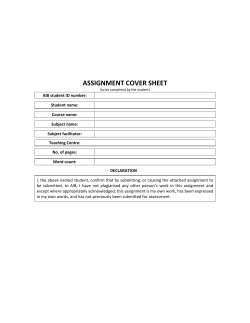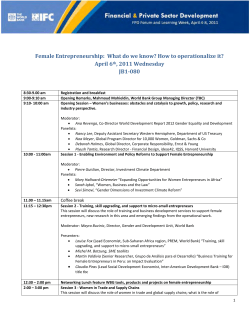
Remote Service from ZEISS Technical Description
Remote Service from ZEISS Technical Description The moment you realize that we're there when you need us. This is the moment we work for. // CUSTOMER CARE MADE BY ZEISS 2 ZEISS Remote Service What is Remote Service? The increasing networking of medical equipment and the rising speed of data transfer paths are broadening the opportunities for direct support in the service field. The main purpose of this document is to explain the technical principles and security aspects of ZEISS Remote Service. With the help of the latest remote support technologies, ZEISS can offer its customers shorter service response times, accompanied by higher system availability in line with current trends. In the past, customers had to wait for a service engineer to call. Today, many issues can be resolved directly by remote means. However, certain constraints arising from regulatory and statutory conditions for medical products have to be taken into account in the remote servicing of medical equipment. In particular, the confidentiality of patient data, security in the manipulation of medical data and guaranteeing the security and effectiveness of the medical instrument being serviced must be considered. Essentially, Remote Service offers support for the following aspects: • Questions regarding the application of the system • Software updates and upgrades • Technical support Our specialists are directly available to you with active support and advice – all online on your display. You always have full control over the applications that you want to make accessible to our support staff. 3 ZEISS Remote Service Setting up a session The setup of a session is shown below: 1 The moderator (ZEISS Service) 4 In the next step, the moderator 6 The operator server returns the launches the moderator program which provides the attendee with the six- address of the communication server, for sends the operator server (VMS) an digit session number by telephone which the moderator program is waiting. invitation to the session. or invitation e-mail. If required, more than two participants can join a remote 2 Once the moderator has been session simultaneously (e.g a customer, successfully authenticated, the operator a ZEISS service engineer and a ZEISS server sends a six-digit session number 2nd level service engineer with special and the address of the communication product know-how). 7 The attendee programs contact the communication server. 8 The session is then set up between the moderator program and the attendee program via the communication server. server (KS) back to the moderator. 5 The attendees launch the attendee 3 The moderator program contacts the program and enter the session number communication server and waits till the in the appropriate field. The attendee attendees join the session. programs then send a request to the operator server. 4 8 8 3 KS 7 2 6 1 5 VMS Moderator (ZEISS Service) Firewall Fig. 1 Setting up a remote service connection 4 Demilitarized Zone (DMZ) Firewall Attendee Security Encryption methods Mutual authentication between clients and servers is realized using an asymmetric encryption method. The public and private keys are hard-coded into the software. The moderator program uses the server's public key and its own private key, while the server uses its own private key and the client's public key. Data privacy and integrity are insured by two encryption methods: ECC (Elliptic Curve Cryptography) and Blowfish. The asymmetric 160-bit ECC keys are used for authentication and for exchanging keys. The symmetric 128-bit Blowfish key secures the integrity and confidentiality of communication between the moderator and attendees. The encryption certificates are issued by an independent certifying body (Verisign). 5 Security at the application level When the moderator program is launched During the session with access to the central ZEISS domain, The privacy of all session participants the moderator is directly authenticated and any personal data are protected intended to be transferred to session via a dedicated assignment of rights to during a Remote Service session by participants can be explicitly deselected. certain user groups in the ZEISS Active several functions and configurations. It is possible, for example, to hide the Directory. He can then launch a new • All Remote Support actions can be desktop or the taskbar. Applications and observed by the attendees during screen elements which are not released session immediately. If the moderator is not connected to the ZEISS domain, he is authenticated using his personal user the session. • Neither the moderator nor the • Applications or files that are not cannot be operated by remote control. • The participant who is sharing his or name and password directly via integrated attendees can obtain remote control her screen can interrupt screen transfer user management and the security of a participant's computer without and transmit a still image in order to his or her consent. process confidential data or applications mechanisms of the ZEISS Netviewer platform. Once the moderator program • The session participants have to explicitly during the session (pause function of the monitor tray). is successfully launched, a unique six- allow any change in the status of their digit session number is generated by computer (change of viewing direction, the operator server and forwarded to remote control, file transfer). Another immediately withdrawn from the the moderator program. This number is participant is only able to remotely session participant using the security passed on to the attendees by telephone control the computer or carry out other key (standard is F11). or by e-mail (see Figure 1). actions after permission is given. 6 • The right of remote control can be Reporting and recording • The moderator can remove individual attendees from the session. • The moderator can block the session to additional attendees. • The attendee can cancel the session Reports of every session are created on the ZEISS Remote Service server. The date, time, session moderator, duration of the session, the number of bytes transferred etc. are recorded. at any time. • Background file transfers are not All session data including video and audio possible. The attendee can observe data can also be recorded by the attendee all file transfers and cancel them concerned on the client side and if if appropriate. necessary saved for subsequent review. 7 Network security Network security Communication The servers of the Remote Service Communication during a Remote Service Both TCP-based and HTTPS/HTTP-based platform are located in a specially secured session can take place either via the HTTP communication only require the ZEISS network segment – the Demilitarized Zone port 80 or the TCP ports 2000 or 443. Remote Service server network addresses (DMZ) – which is protected by firewalls The attendee programs will first try to use to be accessible via the port in question – both from the ZEISS corporate network TCP port 2000 or 443, then HTTPS (SSL) full Internet access from the device and externally from the Internet. via port 443 and after that port 80. is not needed. The network addresses The network addresses of the ZEISS If the firewall allows communication via ZEISS Service at the email address Remote Service server are hard-coded into one of the TCP ports, the session data support.datamanagement@zeiss.com. the attendee and moderator programs. will be transferred directly by TCP. If the This ensures that sessions cannot be firewall blocks TCP communication, the redirected via servers other than the connection is set up via HTTPS port 433 ZEISS Remote Service servers. or HTTP port 80 and therefore normally can, if needed, be requested from via a proxy server. PORT 2000 (TCP) PORT 433 (TCP) These measures prevent any unauthorized access to customer systems via the Remote The use of TCP-based communication Service platform. can improve the session's performance. PORT 433 (HTTPS) PORT 80 (HTTP post) PORT 80 (HTTP get) Program Abort 8 Data privacy Organizational measures • Only trained and certified engineers are • Within the framework of the service assigned to the Remote Service agreement, an additional Remote department at ZEISS. They are given Service agreement can be concluded special training in Remote Service in which sets forth precise details of the addition to their product-specific training accountability and responsibility. courses. • Every Remote Service engineer is given • In parallel to the Remote Service session, a special briefing and has to give telephone communication always takes undertakings relating to data privacy place to keep attendees informed of and data security. the actions carried out. • Access to the ZEISS Remote Service platform is gained by additional authentication. Access is only granted to engineers who have successfully completed the required trainings and participated in the briefing mentioned above and have then given written undertakings relating to data privacy and data security. 9 Summary The security of the ZEISS Remote Service solution and the integrity of the transmitted data is guaranteed by the use of a number of security mechanisms. • Certification by an independent certifying body (VeriSign). • 160-bit ECC key for mutual authentication and asymmetric encryption between client and server. • 128-bit Blowfish key to encrypt session data. • Operator server and communication • Session data can be recorded for subsequent auditing. • A new session number is generated for every session. • No actions can be carried out on a session participant's computer without explicit agreement. That applies to both the moderator and the attendees. server are independent entities. • Optionally, a session password may • Addresses of the ZEISS Remote be used in setting up a connection. Service servers hard-coded into attendee program. • Keys hard-coded into software. • Exchange of session number takes place by a separate medium (telephone or e-mail). • Session between client and server with end-to-end encryption. • The moderator can remove individual attendees from the session. • The moderator can block the session to additional attendees. • When the moderator leaves the session, the session is ended. • The attendee can cancel the session at any time. • Reports on session can be made • Background file transfers are not possible. by the moderator, by attendees The attendee can observe all file transfers or on the server. and cancel them if appropriate. If you have any further questions about Remote Service, please get in touch with your local ZEISS contact. 10 Your notes: 11 Carl Zeiss Meditec AG Göschwitzer Straße 51–52 D-07745 Jena Germany www.meditec.zeiss.com/contacts www.meditec.zeiss.com/customercare The content of this publication may differ from the current licensing of the service in your country. For further information, please contact our regional representatives. Printed on elementary chlorine-free bleached paper. © Carl Zeiss Meditec AG, 2014. All copyrights reserved. EN_30_025_00910I Printed in Germany CZ-X/2014
© Copyright 2025


















